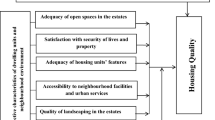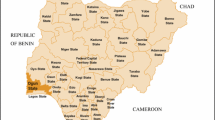Abstract
The need to ensure the production of quality housing has been of remarkable interest to the government of Nigeria, as housing quality is considered to be a symbol of a country with an effective housing delivery system. However, government policy responses to the need to provide quality housing achieved little or nothing. Indeed, the actual provision of housing came nowhere close to the targets specified in the national housing policy. Many houses in Nigeria are obtained through other modes of formal and informal delivery processes, which influence the timing, quality, location and cost of housing. Moreover, there is little consensus on what constitutes ‘quality’ housing, and why different forms of housing delivery—within the public and private sectors—are predominantly failing to deliver what people consider to be ‘quality’. This study was conducted to provide insights on how different stakeholders perceive and make sense of quality housing, and these stakeholders include tenants, home-owners, government officials and Community Development Associations (CDAs) in Benin City. This was achieved through the analysis of data generated from the semi-structured interviews. This paper contributes to knowledge by providing newer dimensions to which housing quality can be defined as one which is spacious, clean, accessible and habitable in terms of the finesse of the interior of the building. It should have good water supply and electricity supply; the environment should be quiet and conducive and the structure/building or house should be accessible by roads. It should be secured and comfortable.








Similar content being viewed by others
Notes
Building materials that lack structural strength and functionality in addition to the influx of poor quality materials into the Nigeria market which are hard to differentiate from the original ones (Ezeanah 2018).
The Binis are a cultural group living in or around Benin City in Nigeria. They are an ethnic group of the population of Benin City.
This neighbourhood reflects in a very distinctive manner a mix of the different socio-economic levels; here, we have a mix the low-, middle- and high-income earners respectively.
It is mainly characterized by middle-income earners and some low-income earners due to the presence of the civil servants as reported from the responses of interviewees.
References
Adebayo, W. O., & Jegede, O. A. (2010). The environmental impact of flooding on transportation land use in Benin City, Nigeria. African Research Review, 4(1), 390–400.
Adeniyi, E. O. (1974). The provision of housing. A challenge to urban planning and development in Africa. Lagos: Wiser Publication.
Alsayyad, N. (1993). Squatting and culture: a comparative analysis of informal developments in Latin America and the Middle East. Habitat International, 17(1), 33–44.
Amao, F. L. (2012). Housing quality in informal settlements and urban upgrading in Ibadan, Nigeria (a case study of Apete in Ibadan). Developing Country Studies, 2(10), 68–80.
Arimah, B. C., & Adeagbo, D. (2000). Compliance with urban development and planning regulations in Ibadan, Nigeria. Habitat International, 24(3), 279–294. https://doi.org/10.1016/S0197-3975(99)00043-0.
Atedhor, G. O., Odjugo, P. A., & Uriri, A. E. (2011). Changing rainfall and anthropogenic-induced flooding: impacts and adaptation strategies in Benin City, Nigeria. Journal of Geography and Regional Planning, 4(1), 42–52.
Awotona, A. (1988). The perception of housing conditions in Nigeria by the urban poor. Habitat International, 12, 75–96.
Awotona, A., & Ogunshakin, L. (1994). Multi-habitation and cultural structures. Experiences from Nigeria. Book of Readings. Dept of Architecture O.A.U., Ile-Ife and CARDO Newcastle U. K.
Berrisford, S. (2013). How to make planning law work for Africa? Africa Research Institute.
Boyatzis, R. E. (1998). Transforming qualitative information: Thematic analysis and code development. Sage.
Bryman, A. (2008). Social research methods, 3rd edn. Oxford: Oxford University Press.
Chukwuocha, A. C., & AC-Chukwuocha, N. (2014). Geographic information system planning and monitoring best practices for West Africa. African Journal of Environmental Science and Technology, 8(1), 31–40.
CMHC (Canada Mortgage and Housing Corporation) (1991). Core housing need in Canada. Ottawa: CMHC.
Collier, P., & Venables, A. J. (2014). Housing and urbanization in Africa: unleashing a formal market process. Policy Research Working Paper 6871.
Cope, M. (2005). Coding qualitative data. Qualitative research methods in human geography, 2, 223–233.
Dark, P. J. C. (1973) An Introduction to Benin Art and Technology. Oxford: Clarendon Press
Dung-Gwom, J. Y., & Magaji, J. Y. (2007). The environmental health problems associated with solid waste management in Gwagwalada, Abuja. C Nigeria. World Congress on Housing XXXVIIAHS.
Ebong, M. O. (1983). The perception of residential quality: a case study of Calabar, Nigeria. Third World Planning Review, 5(3), 273–284.
Ede, A. N. (2013). Building collapse in Nigeria: the trend of casualties the last decade (2000-2010). International Journal of Civil and Environmental Engineering, 10(6), 32–36.
Edo State government. (1996). http://www.edostate.gov.ng/.
Ekhaese, E. N. (2011). Domestic architecture in Benin City: a study of continuity and change, an unpublished. Ota: Ph.D. Thesis in the Department of Architecture, School of Environmental Science, Covenant University.
Ekhaese, E. N., & Amole, B. (2014). Benin domestic architecture “a tabula rasa” for transition: From pre-independence to contemporary architecture. International Journal of Social Sciences and Entrepreneurship, 1(9), 264–287.
Ezeanah, U. (2018). The delivery of quality housing in Benin City: the influence of formal and informal institutions, an unpublished. Sheffield: PhD Thesis in the Department of Urban Studies and Planning, The University of Sheffield.
Farvacque, C., & McAuslan, P. (1991). Reforming urban land policies and institutions in developing countries. Washington: The World Bank.
Hanmer, L., Booth, D., & Lovell. E. (2000). Poverty and Transport: A Report prepared for the World Bank in Collaboration with DFID, Overseas Development Institute.
HUD User website. (2003). Worst Case Housing Need 2003 Report.
Ikhuoria, I. A. (1984). Rapid urban growth and urban land use patterns in Benin City, Nigeria.
Jiboye, A. (2004). An Assessment of the influence of Socio-cultural factors on Housing quality in Osogbo, Nigeria, Unpublished M.Sc. Thesis, Department of Urban and regional Planning, Obafemi Awolowo University, Ile-Ife, Nigeria. In Amao, F.L. (2012) Housing quality in formal settlements and urban upgrading in Ibadan, Nigeria Developing Countries Studies, Vol 2, No.10. www.iiste.org
Jiboye, A. D. (2009). Evaluating tenants’ satisfaction with public housing in Lagos, Nigeria. Urbanistika ir architektūra Town Planning and Architecture, 33(4), 239–247.
Kaitilla, S. (1993). Satisfaction with public housing in Papua New Guinea: the case of west Taraka Housing Scheme. Environment and Behavior, 25(3), 514–545.
Lang, S., Sunder, M. (2003) Non-parametric regression with BayesX: a flexible estimation of trends in human physical stature in 19th century America. Economics & Human Biology 1 (1):77–89. https://doi.org/10.1007/s12132-020-09409-1
Lusugga Kironde, J. M. (2006). The regulatory framework, unplanned development, and urban poverty: findings from Dar es Salaam, Tanzania. Land Use Policy, 23(4), 460–472. https://doi.org/10.1016/j.landusepol.2005.07.004.
Makinde, O. O. (2013). Housing delivery system need and demand. Journal of Environmental Development and Sustainability., 16(1), 49–69.
Makinde, O. O. (2017). Evaluating public housing quality in Ogun State, Nigeria. Environment, Development and Sustainability, 19(5), 1879–1909.
Mason, J. (2002). Qualitative researching (2nd ed.). London: SAGE Publications Ltd..
McLeod, R. (2003). Guidelines for the Revision of Regulations for Urban Upgrading – Insights from the Federation Process. Homeless International, United Kingdom.
McLellan, E., MacQueen, K. M., and Neidig, J. L. (2003). Beyond the Qualitative Interview: Data Preparation and Transcription. Field Methods, 15(1), pp. 63-84.
Meng, G., & Hall, G. B. (2006). Assessing housing quality in metropolitan Lima, Peru. Journal of Housing and the Built Environment, 21(4), 413–439.
Neilson, M. (2004). Scottish Housing Quality Standard (SHQS). Scottish executive development department. Available at www.scotland.gov.uk
Odjugo, P. A., Enaruvbe, G. O., & Isibor, H. O. (2015). Geospatial approach to spatio-temporal pattern of urban growth in Benin City, Nigeria. African Journal of Environmental Science and Technology, 9(3), 166–175.
Ogu, V. I. (1999). Housing enablement in a developing world city: the case study of Benin City, Nigeria. Habitat International, 23(2), 231–248.
Ogu, V. I. (2009). Urban infrastructure development and sustainability in Nigeria. Human Settlement Development-Volume III, 109
Okewole, I. A., & Aribigbola, A. (2006). Innovations and sustainability in housing policy conception and implementation in Nigeria 414-420.
Olayiwola, L. M., Adeleye ,A., & Jiboye, A. D. (2006). Effect of socio-cultural factors on housing quality in Osogbo, Nigeria. International Symposium on Construction in Developing Economies: New issues and challenges. Santiago, Chile. 18-29.
Olotuah, O., & Olukayode, A. (2007). Housing quality in suburban areas (an empirical study of Oba-Ile, Nigeria). DIMENSI (Journal of Architecture and Built Environment), 34(2), 133–137.
Omuta, G. E. D. (1986). Minimum versus affordable environmental standards in third world cities. Cities, 3(1), 58–71.
Otubu, A. K. (2008). Housing needs and land administration in Nigeria: land and real property rights in Nigeria: Smith, I.O. (ED) Faculty of Law, University of Lagos.
Rapoport, A. (1976). Socio-cultural aspects of man-environment studies. In A. Rapoport (Ed.), The mutual interaction of people and their built environment. The Hague: Monton.
Sengupta, U., & Tipple, A. G. (2007). The performance of public-sector housing in Kolkata, India, in the post-reform milieu. Urban Studies, 44(10), 2009–2037.
Stake, R. (2000). Case studies. In N. K. Denzin & Y. S. Lincoln (Eds.), Handbook of qualitative research (pp. 435–451). Thousand Oaks: Sage.
The Columbia Encyclopedia. (2007). Columbia University Press. Retrieved February, 18, 2007
Udechukwu, C. E. (2008). Obstacles to individual home ownership in Nigeria. International of Housing Markets and Analysis, 1(2), 182–194.
Watson, V. (2009) Seeing from the South: Refocusing Urban Planning on the Globe’s Central Urban Issues. Urban Studies 46(11):2259–2275.
Vanguard (2011). IBB and Delta State Creation. Prof Omoruyis account not well informed. pp. 1–4. Available online at online at http://www.vanguardngr.com/2011/02/ibb-delta-state-creation-lllprof-omoruyis-account-not-well-informed-%e2%80%94prof-oyovbaire/
Acknowledgements
I wish to acknowledge the support of my supervisors Dr. Tom Goodfellow and Dr. Paula Meth, University of Sheffield, for their constructive feedback during my PhD. Financial support was received from International Journal of Urban and Regional Research (FURS Writing-up grant) and the Faculty of Social Science Research Support Scheme, University of Sheffield, during the course of my PhD Studies.
Author information
Authors and Affiliations
Corresponding author
Additional information
Publisher’s Note
Springer Nature remains neutral with regard to jurisdictional claims in published maps and institutional affiliations.
Appendix
Appendix
Rights and permissions
About this article
Cite this article
Ezeanah, U. Quality Housing: Perception and Insights of People in Benin City, Nigeria. Urban Forum 32, 87–110 (2021). https://doi.org/10.1007/s12132-020-09409-1
Published:
Issue Date:
DOI: https://doi.org/10.1007/s12132-020-09409-1




